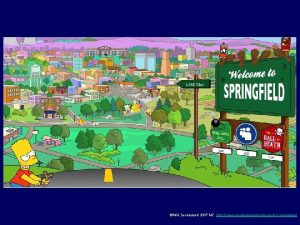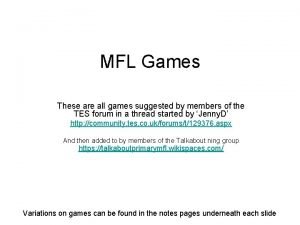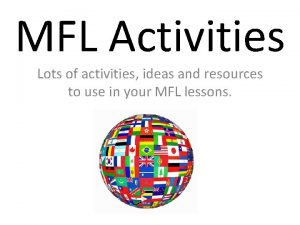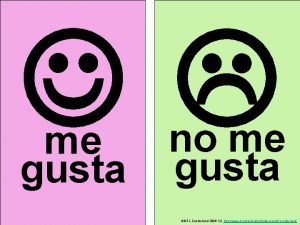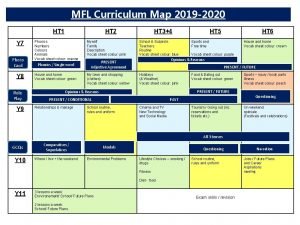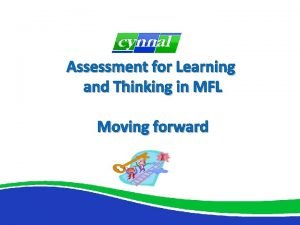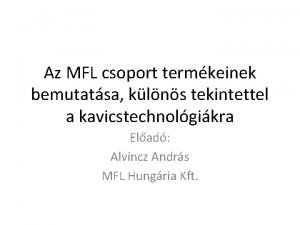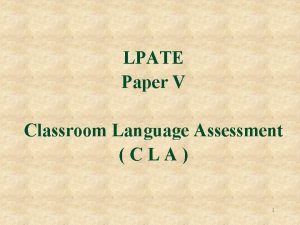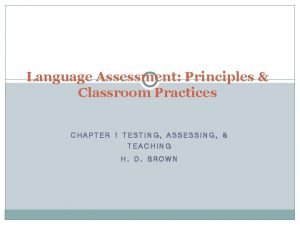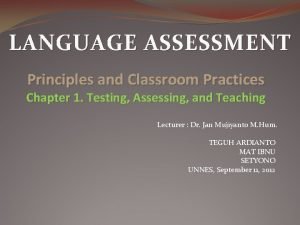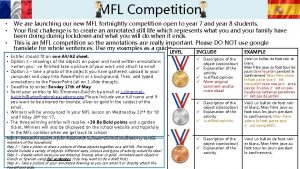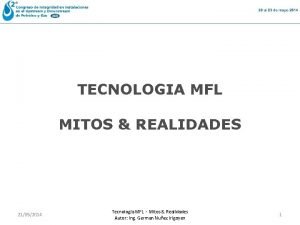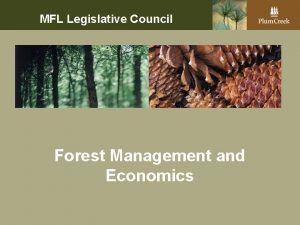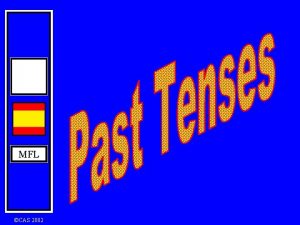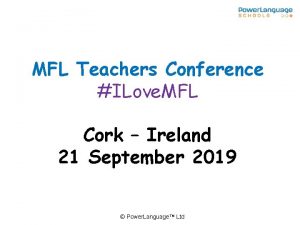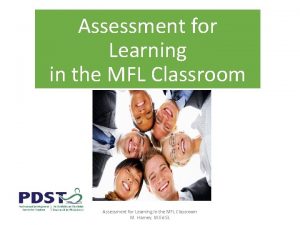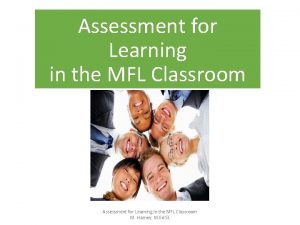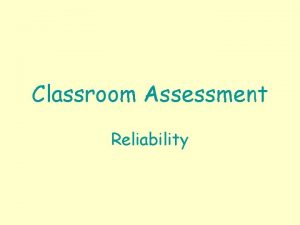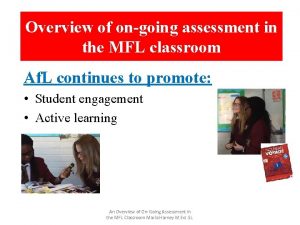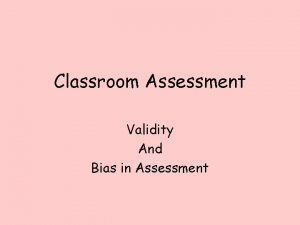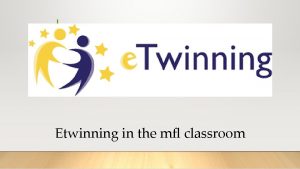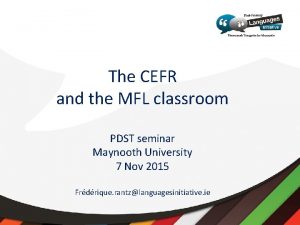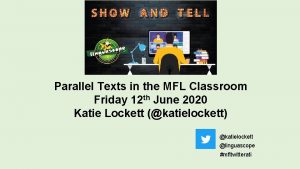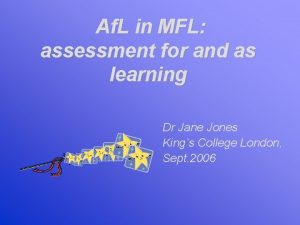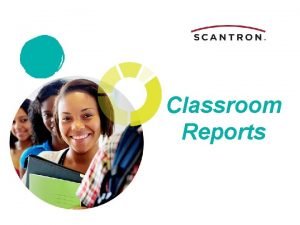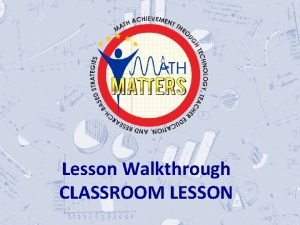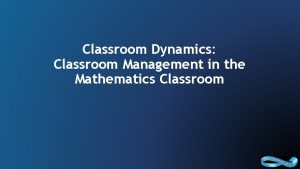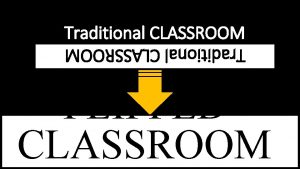Assessment for Learning in the MFL Classroom M






































- Slides: 38

Assessment for Learning in the MFL Classroom M. Harney. M. Ed SL

WALT? 1. What does Af. L mean for our teaching? 2. See how it fits into the MFL Classroom 3. See Ideas and Sample techniques for MFL teaching 4. Hear Student responses to Af. L Assessment for Learning in the MFL Classroom M. Harney. M. Ed SL

Types of Assessment: Summative and Formative • Summative Assessment: provides a picture of a student’s performance at a specific time. • Formative Assessment: informs the learner and teacher of the next step in the learning process • Balance of Formative and Summative is necessary. Assessment for Learning in the MFL Classroom M. Harney. M. Ed SL

What exactly is Af. L ? How do I use it in my classroom? Assessment for Learning in the MFL Classroom M. Harney. M. Ed SL

You are already! Sharing the learning intention and success criteria Self assessment Effective questioning Peer assessment Formative feedback Assessment for Learning in the MFL Classroom M. Harney. M. Ed SL

Af. L: Teaching and Learning that encourages both the teacher and the learner to become aware of Where students are at in their learning What areas need to worked on How to improve these areas Assessment for Learning in the MFL Classroom M. Harney. M. Ed SL = Af. L (Teaching a learning skills)

Some Af. L techniques Assessment for Learning in the MFL Classroom M. Harney. M. Ed SL

What are learning intentions? • Learning intentions are statements that describe the learning activities/tasks that a lesson or series of lessons will focus on. • They are frequently linked to one or more learning outcome. • Learning intentions also identify the new learning that will take place in class (PDST) Assessment for Learning in the MFL Classroom M. Harney. M. Ed SL

Sharing the learning intention and success criteria • Topic • Learning intentions • Success criteria Assessment for Learning in the MFL Classroom M. Harney. M. Ed SL

Establishing Criteria for Success • • • Clear and simple points Generate these with the students A good answer should have. . . . I am looking for. . . In your answer These can then be used further for self and peer assessment Assessment for Learning in the MFL Classroom M. Harney. M. Ed SL

Assessment for Learning in the MFL Classroom M. Harney. M. Ed SL

Why are success criteria important? • Improve understanding • Empower students • Encourage independent learning • Enable effective feedback • Are linked to the learning intentions • Are specific to an activity/task • Are discussed and agreed with students prior to undertaking the activity/task • Provide a scaffold and focus for students while engaged in the activity/task • Are used as the basis for feedback, peer-assessment and selfassessment (PDST) Assessment for Learning in the MFL Classroom M. Harney. M. Ed SL

Revisiting the learning intention • Thumbs up / happy faces (Thumbometre!!!) • Think pair share Assessment for Learning in the MFL Classroom M. Harney. M. Ed SL

Smiley Faces Students draw smiley faces to describe where they are at with their learning of a topic Confident and Ready to move on Not quite there but more practice and help needed to feel confident Assessment for Learning in the MFL Classroom M. Harney. M. Ed SL Confused and need to look at this topic again

Traffic Lights Use traffic lights as a visual means of showing understanding. Assessment for Learning in the MFL Classroom M. Harney. M. Ed SL

Just a Minute Quiz!!! Students have 60 seconds to share as much as they have learned from the lesson. Assessment for Learning in the MFL Classroom M. Harney. M. Ed SL

Mini white boards Assessment for Learning in the MFL Classroom M. Harney. M. Ed SL

What do we mean by formative feedback? • ‘Feedback to any student should be about the particular qualities of his or her work, with advice on what he or she can do to improve, and should avoid comparisons with other students. ’ (PDST) Assessment for Learning in the MFL Classroom M. Harney. M. Ed SL

For feedback to be effective • Relate the feedback to the learning intention and success criteria • Identify where success has occurred • Set a goal for improvement • Show where and how improvement could take place • Allow time for students to make improvements • Start small (PDST) Assessment for Learning in the MFL Classroom M. Harney. M. Ed SL

Assessment for Learning in the MFL Classroom M. Harney. M. Ed SL

Exemplar work and redrafting Assessment for Learning in the MFL Classroom M. Harney. M. Ed SL

formative Exit ticket feedback Password – they have to answer a question – or give one thing they learned as they exit Assessment for Learning in the MFL Classroom M. Harney. M. Ed SL

Easi-speak microphones Assessment for Learning in the MFL Classroom M. Harney. M. Ed SL

Assessment for Learning in the MFL Classroom M. Harney. M. Ed SL

How peer assessment/peer feedback can support student reflection? • Feedback is in a language that the students use • Strengthens the student voice in the classroom • Can produce valuable feedback (PDST) Assessment for Learning in the MFL Classroom M. Harney. M. Ed SL

Effective questioning • It is the framing, delivering, timing, soliciting and responding to questions in order to provide information about student knowledge, understanding and skills that informs the teacher's planning and selection of teaching strategies to move students from where they are to where they need to go. • Research shows that teachers ask approximately one question every 72 seconds. …… 38% of these are actually answered by the teacher (PDST) Assessment for Learning in the MFL Classroom M. Harney. M. Ed SL

Students write Questions ·About what you would like to know on a new topic ·To ask the teacher or other students in order to assess their learning Assessment for Learning in the MFL Classroom M. Harney. M. Ed SL

Make questioning more effective • Ask fewer questions • Ask more ‘open’ questions • Sequence questions • Prepare key questions Ask in a way that • Involves the whole class • Think, pair, share • Provide think time • Try ‘no hands up’ • Use wrong answers to develop understanding • Prompt students • Listen and respond positively • Model questioning for students • Provide opportunities for students to practice their skills • Plan time for students’ questions and for dealing with them effectively (PDST) Assessment for Learning in the MFL Classroom M. Harney. M. Ed SL

Effective questioning “Emma, how could you develop Siobhan’s answer to include more detail? ” “Paul, how might you combine all we’ve heard into a single answer? ” Assessment for Learning in the MFL Classroom M. Harney. M. Ed SL

Effective questioning Wait-time 3 -5 seconds Assessment for Learning in the MFL Classroom M. Harney. M. Ed SL

Benefits of Af. L Assessment for Learning in the MFL Classroom M. Harney. M. Ed SL

What the students said 1 st – 5 th year “Before I wouldn’t know what or why I was making a particular mistake, but now I know” “They make me feel good about what I’ve done and where I’m at while also showing me what I have to work on” “It is a different way of learning and an easier way” Assessment for Learning in the MFL Classroom M. Harney. M. Ed SL “Makes you want to learn more”

(2013, M. Harney): 78 students, 3 classes, 3 different teachers Q. Do the following modes of Af. L help you in your learning? 70 60 50 40 30 20 10 0 Establishing Learning Goals Revisiting Learning Goals Peer Self Assessment for Learning in the MFL Classroom M. Harney. M. Ed SL Clarifying Learning Criteria yes no sometimes blank

Do you find it helpful when the teacher goes through the Objectives Board at the start of a class? No 13% Yes 87% Assessment for Learning in the MFL Classroom M. Harney. M. Ed SL

3: I use the Objectives Board for: To identify my challenges and strengths 13% Organising myself 17% Updating myself 6% To understand what I am learning 22% To know what I am supposed to be doing in class 27% Assessment for Learning in the MFL Classroom M. Harney. M. Ed SL Refocusing myself 15%

Start with a small change in your mfl class , one technique and build from there. Assessment for Learning in the MFL Classroom M. Harney. M. Ed SL

Revisiting our intentions …. . 1. Af. L ensures meaningful and engaged teaching and learning in all classrooms 2. Af. L fits naturally and easily into the MFL Classroom 3. As MFL teachers, our subjects are vibrant and we use a lot of Af. L techniques already 4. Language is made to be spoken, Af. L creates a fun and natural class for the MFL student. Assessment for Learning in the MFL Classroom M. Harney. M. Ed SL

Merci, Danke, Gracias, Grazie! Assessment for Learning in the MFL Classroom M. Harney. M. Ed SL
 Glatzhaarig
Glatzhaarig Www.atantot-extra.co.uk
Www.atantot-extra.co.uk Dictation room
Dictation room Mfl sunderland
Mfl sunderland Sunderland mfl
Sunderland mfl Mfl curriculum map
Mfl curriculum map Questioning in mfl
Questioning in mfl Sunderland mfl
Sunderland mfl Mfl austria
Mfl austria Btech smart classes
Btech smart classes Cuadro comparativo entre e-learning b-learning y m-learning
Cuadro comparativo entre e-learning b-learning y m-learning Lpat classroom language assessment
Lpat classroom language assessment Language assessment principles and classroom practices
Language assessment principles and classroom practices What is summative evaluation
What is summative evaluation Advantages of learning outside the classroom
Advantages of learning outside the classroom Advantages of learning outside the classroom
Advantages of learning outside the classroom Classroom strategies for interactive learning
Classroom strategies for interactive learning Fspos vägledning för kontinuitetshantering
Fspos vägledning för kontinuitetshantering Typiska novell drag
Typiska novell drag Nationell inriktning för artificiell intelligens
Nationell inriktning för artificiell intelligens Returpilarna
Returpilarna Varför kallas perioden 1918-1939 för mellankrigstiden?
Varför kallas perioden 1918-1939 för mellankrigstiden? En lathund för arbete med kontinuitetshantering
En lathund för arbete med kontinuitetshantering Särskild löneskatt för pensionskostnader
Särskild löneskatt för pensionskostnader Tidbok
Tidbok Anatomi organ reproduksi
Anatomi organ reproduksi Förklara densitet för barn
Förklara densitet för barn Datorkunskap för nybörjare
Datorkunskap för nybörjare Tack för att ni lyssnade bild
Tack för att ni lyssnade bild Mall för debattartikel
Mall för debattartikel Magnetsjukhus
Magnetsjukhus Nyckelkompetenser för livslångt lärande
Nyckelkompetenser för livslångt lärande Påbyggnader för flakfordon
Påbyggnader för flakfordon Tryck formel
Tryck formel Publik sektor
Publik sektor Jag har nigit för nymånens skära text
Jag har nigit för nymånens skära text Presentera för publik crossboss
Presentera för publik crossboss Jiddisch
Jiddisch Vem räknas som jude
Vem räknas som jude
